University Finance Module: Strategic Finance Report and Analysis
VerifiedAdded on 2020/05/28
|22
|5029
|30
Report
AI Summary
This report delves into the critical role of financial information in strategic management. It begins by evaluating the necessity of financial statements for informed decision-making and assessing business risks. The report then analyzes the financial accounts of Unilever plc, examining their purpose, structure, content, and significance through ratio analysis. Further, the report explores the requirements for both long-term and short-term financing, while also examining cash flow management. The report concludes with an overview of corporate governance and investment appraisal methods, providing a comprehensive understanding of how financial information is used to drive strategic business decisions and improve overall financial performance.
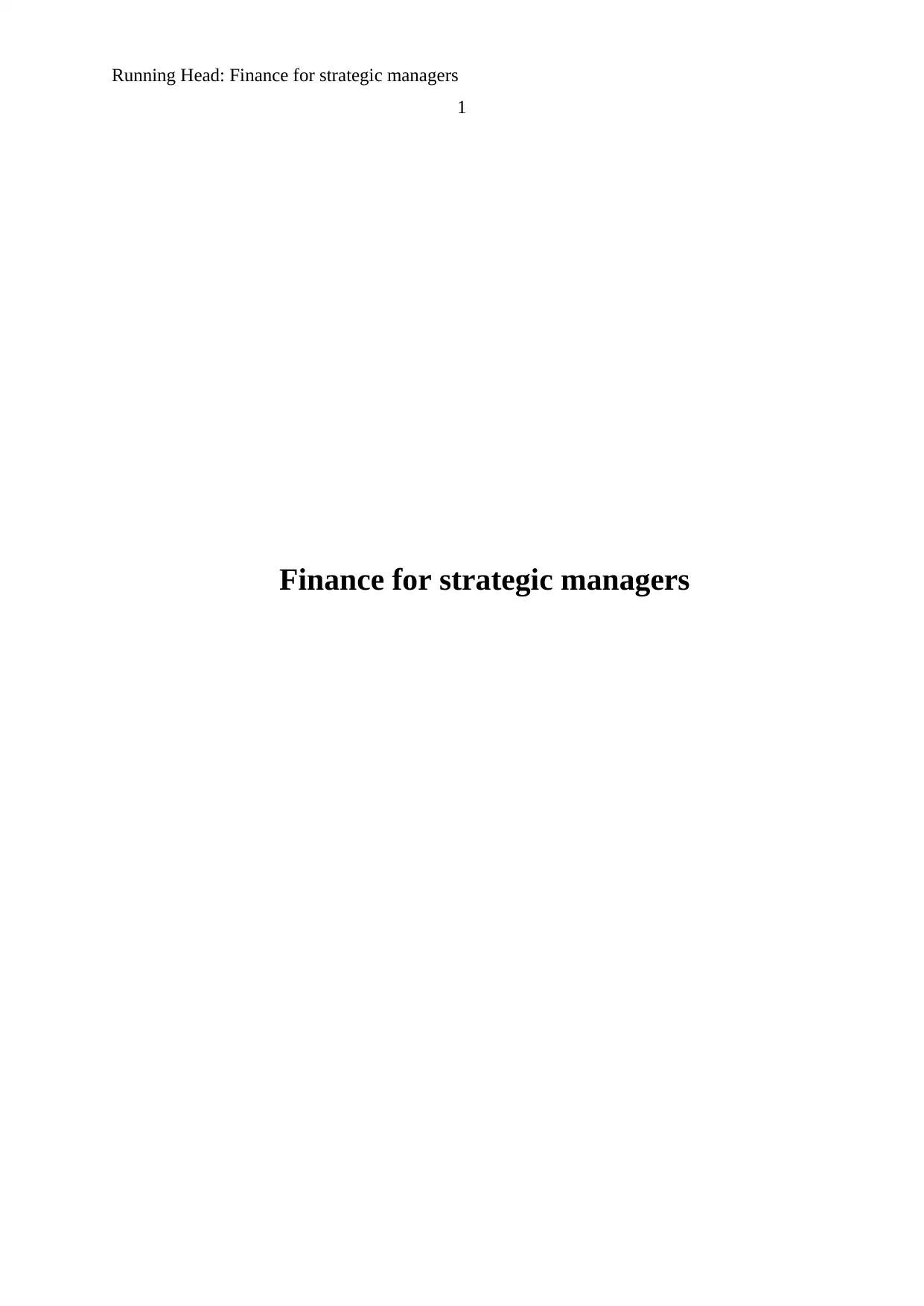
Running Head: Finance for strategic managers
1
Finance for strategic managers
1
Finance for strategic managers
Paraphrase This Document
Need a fresh take? Get an instant paraphrase of this document with our AI Paraphraser
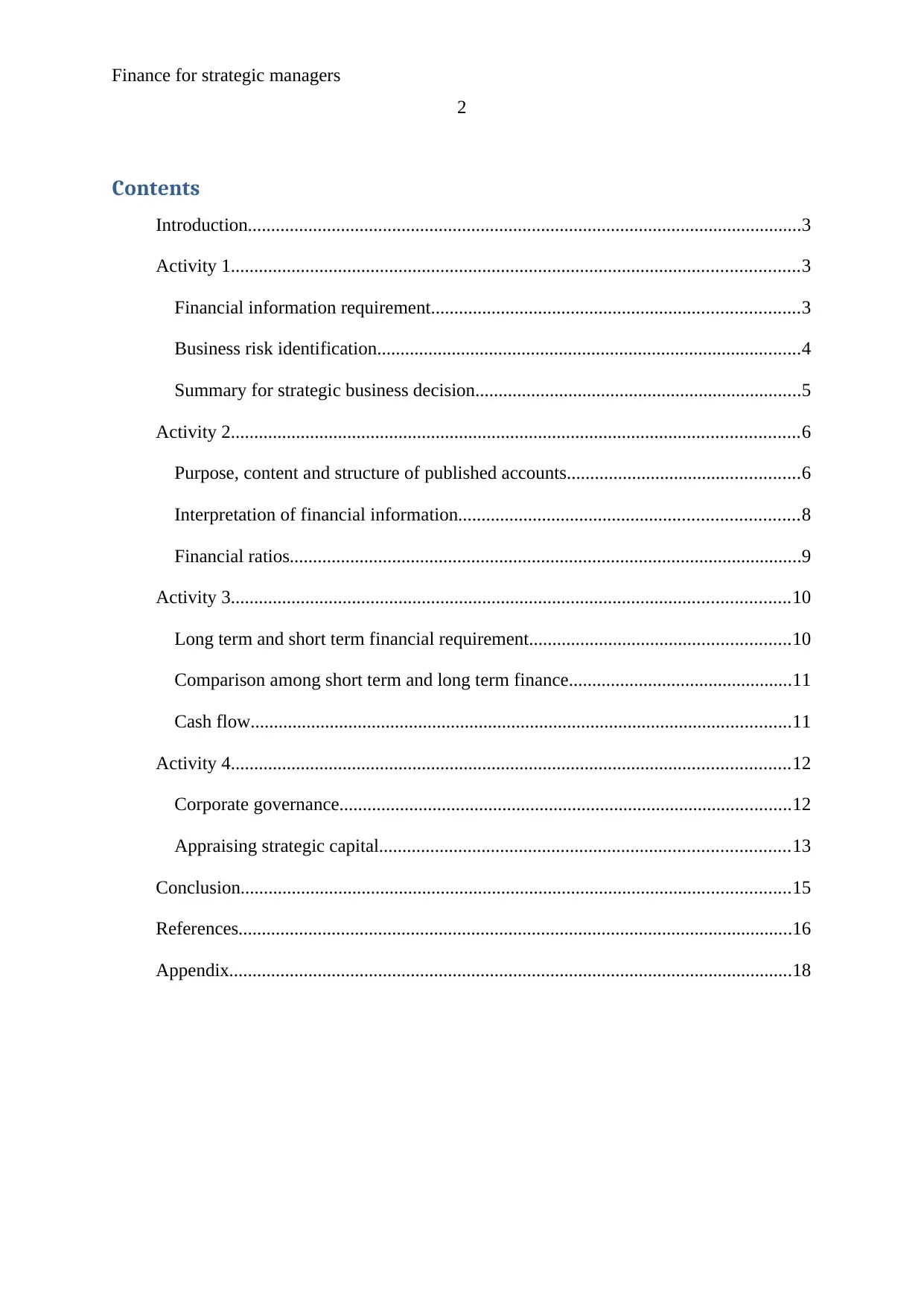
Finance for strategic managers
2
Contents
Introduction.......................................................................................................................3
Activity 1..........................................................................................................................3
Financial information requirement...............................................................................3
Business risk identification...........................................................................................4
Summary for strategic business decision......................................................................5
Activity 2..........................................................................................................................6
Purpose, content and structure of published accounts..................................................6
Interpretation of financial information.........................................................................8
Financial ratios..............................................................................................................9
Activity 3........................................................................................................................10
Long term and short term financial requirement........................................................10
Comparison among short term and long term finance................................................11
Cash flow....................................................................................................................11
Activity 4........................................................................................................................12
Corporate governance.................................................................................................12
Appraising strategic capital........................................................................................13
Conclusion......................................................................................................................15
References.......................................................................................................................16
Appendix.........................................................................................................................18
2
Contents
Introduction.......................................................................................................................3
Activity 1..........................................................................................................................3
Financial information requirement...............................................................................3
Business risk identification...........................................................................................4
Summary for strategic business decision......................................................................5
Activity 2..........................................................................................................................6
Purpose, content and structure of published accounts..................................................6
Interpretation of financial information.........................................................................8
Financial ratios..............................................................................................................9
Activity 3........................................................................................................................10
Long term and short term financial requirement........................................................10
Comparison among short term and long term finance................................................11
Cash flow....................................................................................................................11
Activity 4........................................................................................................................12
Corporate governance.................................................................................................12
Appraising strategic capital........................................................................................13
Conclusion......................................................................................................................15
References.......................................................................................................................16
Appendix.........................................................................................................................18
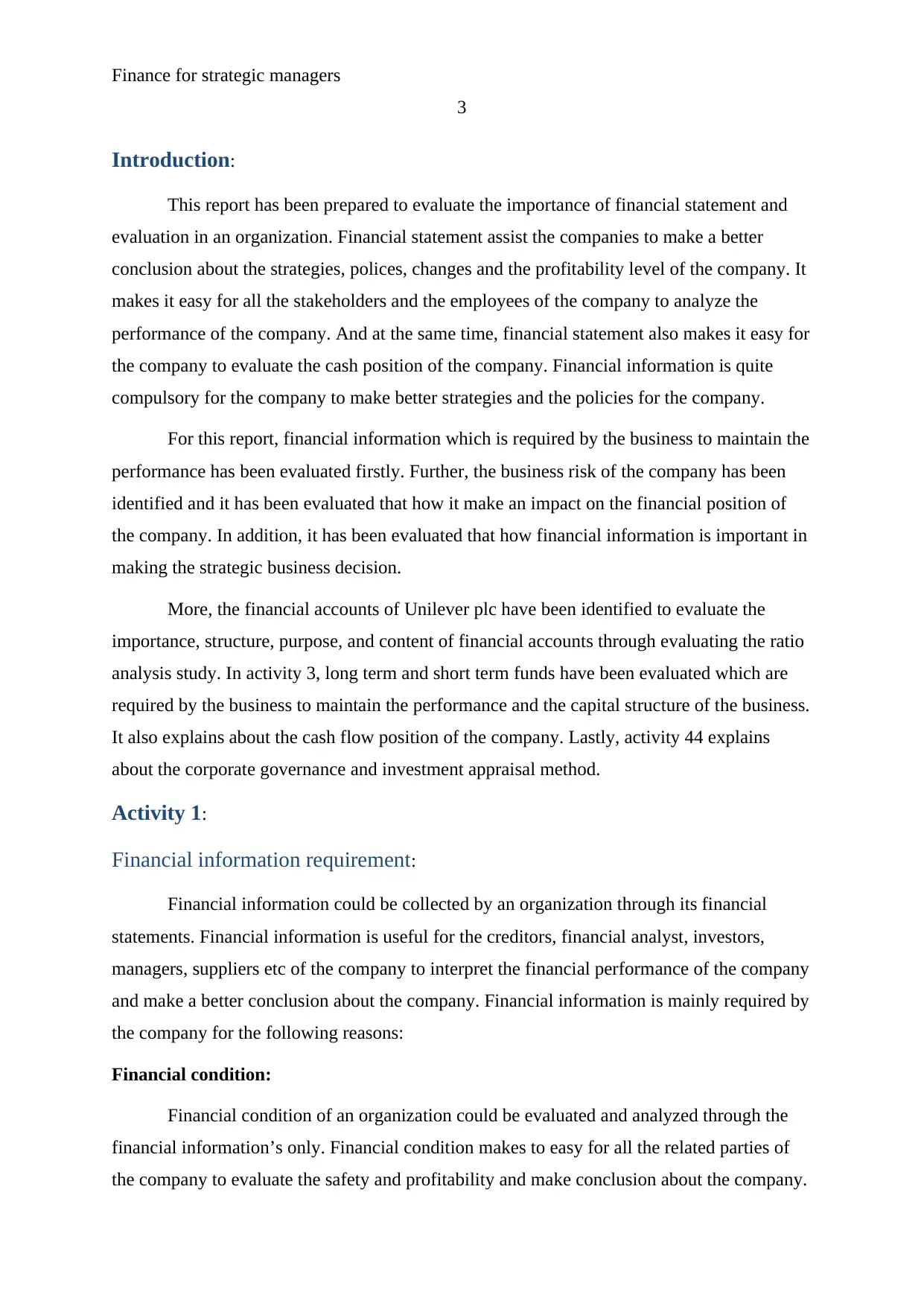
Finance for strategic managers
3
Introduction:
This report has been prepared to evaluate the importance of financial statement and
evaluation in an organization. Financial statement assist the companies to make a better
conclusion about the strategies, polices, changes and the profitability level of the company. It
makes it easy for all the stakeholders and the employees of the company to analyze the
performance of the company. And at the same time, financial statement also makes it easy for
the company to evaluate the cash position of the company. Financial information is quite
compulsory for the company to make better strategies and the policies for the company.
For this report, financial information which is required by the business to maintain the
performance has been evaluated firstly. Further, the business risk of the company has been
identified and it has been evaluated that how it make an impact on the financial position of
the company. In addition, it has been evaluated that how financial information is important in
making the strategic business decision.
More, the financial accounts of Unilever plc have been identified to evaluate the
importance, structure, purpose, and content of financial accounts through evaluating the ratio
analysis study. In activity 3, long term and short term funds have been evaluated which are
required by the business to maintain the performance and the capital structure of the business.
It also explains about the cash flow position of the company. Lastly, activity 44 explains
about the corporate governance and investment appraisal method.
Activity 1:
Financial information requirement:
Financial information could be collected by an organization through its financial
statements. Financial information is useful for the creditors, financial analyst, investors,
managers, suppliers etc of the company to interpret the financial performance of the company
and make a better conclusion about the company. Financial information is mainly required by
the company for the following reasons:
Financial condition:
Financial condition of an organization could be evaluated and analyzed through the
financial information’s only. Financial condition makes to easy for all the related parties of
the company to evaluate the safety and profitability and make conclusion about the company.
3
Introduction:
This report has been prepared to evaluate the importance of financial statement and
evaluation in an organization. Financial statement assist the companies to make a better
conclusion about the strategies, polices, changes and the profitability level of the company. It
makes it easy for all the stakeholders and the employees of the company to analyze the
performance of the company. And at the same time, financial statement also makes it easy for
the company to evaluate the cash position of the company. Financial information is quite
compulsory for the company to make better strategies and the policies for the company.
For this report, financial information which is required by the business to maintain the
performance has been evaluated firstly. Further, the business risk of the company has been
identified and it has been evaluated that how it make an impact on the financial position of
the company. In addition, it has been evaluated that how financial information is important in
making the strategic business decision.
More, the financial accounts of Unilever plc have been identified to evaluate the
importance, structure, purpose, and content of financial accounts through evaluating the ratio
analysis study. In activity 3, long term and short term funds have been evaluated which are
required by the business to maintain the performance and the capital structure of the business.
It also explains about the cash flow position of the company. Lastly, activity 44 explains
about the corporate governance and investment appraisal method.
Activity 1:
Financial information requirement:
Financial information could be collected by an organization through its financial
statements. Financial information is useful for the creditors, financial analyst, investors,
managers, suppliers etc of the company to interpret the financial performance of the company
and make a better conclusion about the company. Financial information is mainly required by
the company for the following reasons:
Financial condition:
Financial condition of an organization could be evaluated and analyzed through the
financial information’s only. Financial condition makes to easy for all the related parties of
the company to evaluate the safety and profitability and make conclusion about the company.
⊘ This is a preview!⊘
Do you want full access?
Subscribe today to unlock all pages.

Trusted by 1+ million students worldwide
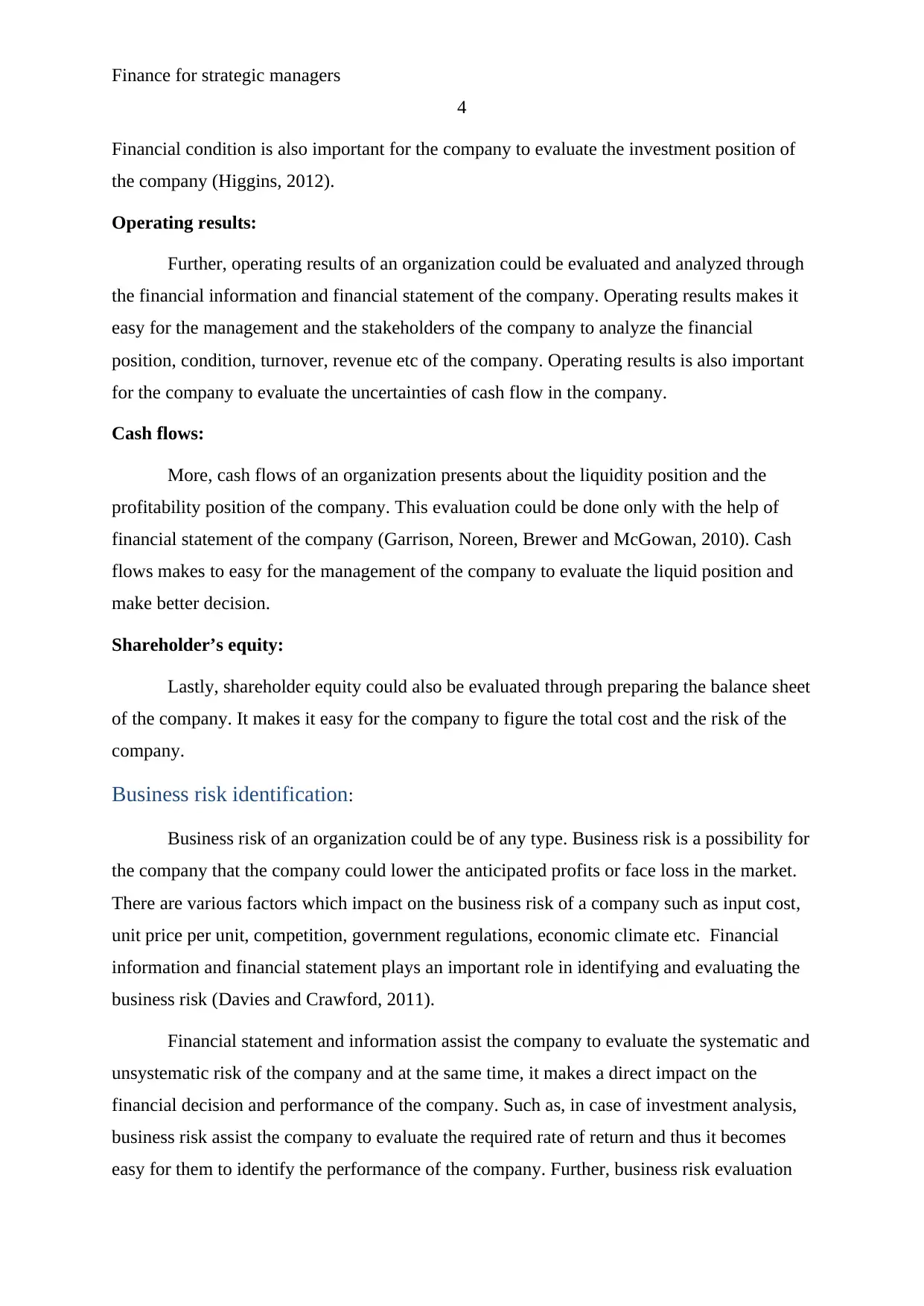
Finance for strategic managers
4
Financial condition is also important for the company to evaluate the investment position of
the company (Higgins, 2012).
Operating results:
Further, operating results of an organization could be evaluated and analyzed through
the financial information and financial statement of the company. Operating results makes it
easy for the management and the stakeholders of the company to analyze the financial
position, condition, turnover, revenue etc of the company. Operating results is also important
for the company to evaluate the uncertainties of cash flow in the company.
Cash flows:
More, cash flows of an organization presents about the liquidity position and the
profitability position of the company. This evaluation could be done only with the help of
financial statement of the company (Garrison, Noreen, Brewer and McGowan, 2010). Cash
flows makes to easy for the management of the company to evaluate the liquid position and
make better decision.
Shareholder’s equity:
Lastly, shareholder equity could also be evaluated through preparing the balance sheet
of the company. It makes it easy for the company to figure the total cost and the risk of the
company.
Business risk identification:
Business risk of an organization could be of any type. Business risk is a possibility for
the company that the company could lower the anticipated profits or face loss in the market.
There are various factors which impact on the business risk of a company such as input cost,
unit price per unit, competition, government regulations, economic climate etc. Financial
information and financial statement plays an important role in identifying and evaluating the
business risk (Davies and Crawford, 2011).
Financial statement and information assist the company to evaluate the systematic and
unsystematic risk of the company and at the same time, it makes a direct impact on the
financial decision and performance of the company. Such as, in case of investment analysis,
business risk assist the company to evaluate the required rate of return and thus it becomes
easy for them to identify the performance of the company. Further, business risk evaluation
4
Financial condition is also important for the company to evaluate the investment position of
the company (Higgins, 2012).
Operating results:
Further, operating results of an organization could be evaluated and analyzed through
the financial information and financial statement of the company. Operating results makes it
easy for the management and the stakeholders of the company to analyze the financial
position, condition, turnover, revenue etc of the company. Operating results is also important
for the company to evaluate the uncertainties of cash flow in the company.
Cash flows:
More, cash flows of an organization presents about the liquidity position and the
profitability position of the company. This evaluation could be done only with the help of
financial statement of the company (Garrison, Noreen, Brewer and McGowan, 2010). Cash
flows makes to easy for the management of the company to evaluate the liquid position and
make better decision.
Shareholder’s equity:
Lastly, shareholder equity could also be evaluated through preparing the balance sheet
of the company. It makes it easy for the company to figure the total cost and the risk of the
company.
Business risk identification:
Business risk of an organization could be of any type. Business risk is a possibility for
the company that the company could lower the anticipated profits or face loss in the market.
There are various factors which impact on the business risk of a company such as input cost,
unit price per unit, competition, government regulations, economic climate etc. Financial
information and financial statement plays an important role in identifying and evaluating the
business risk (Davies and Crawford, 2011).
Financial statement and information assist the company to evaluate the systematic and
unsystematic risk of the company and at the same time, it makes a direct impact on the
financial decision and performance of the company. Such as, in case of investment analysis,
business risk assist the company to evaluate the required rate of return and thus it becomes
easy for them to identify the performance of the company. Further, business risk evaluation
Paraphrase This Document
Need a fresh take? Get an instant paraphrase of this document with our AI Paraphraser
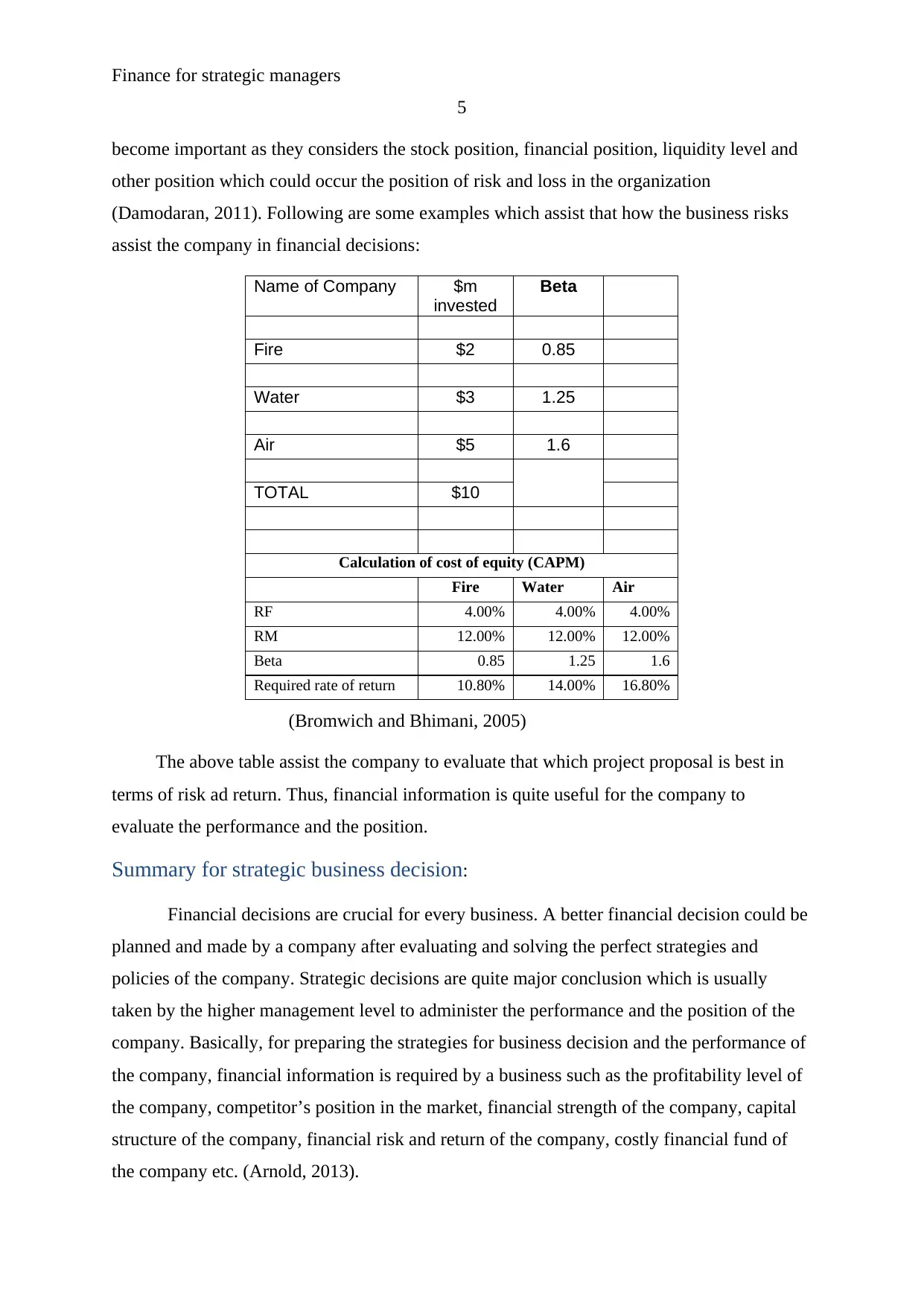
Finance for strategic managers
5
become important as they considers the stock position, financial position, liquidity level and
other position which could occur the position of risk and loss in the organization
(Damodaran, 2011). Following are some examples which assist that how the business risks
assist the company in financial decisions:
Name of Company $m
invested
Beta
Fire $2 0.85
Water $3 1.25
Air $5 1.6
TOTAL $10
Calculation of cost of equity (CAPM)
Fire Water Air
RF 4.00% 4.00% 4.00%
RM 12.00% 12.00% 12.00%
Beta 0.85 1.25 1.6
Required rate of return 10.80% 14.00% 16.80%
(Bromwich and Bhimani, 2005)
The above table assist the company to evaluate that which project proposal is best in
terms of risk ad return. Thus, financial information is quite useful for the company to
evaluate the performance and the position.
Summary for strategic business decision:
Financial decisions are crucial for every business. A better financial decision could be
planned and made by a company after evaluating and solving the perfect strategies and
policies of the company. Strategic decisions are quite major conclusion which is usually
taken by the higher management level to administer the performance and the position of the
company. Basically, for preparing the strategies for business decision and the performance of
the company, financial information is required by a business such as the profitability level of
the company, competitor’s position in the market, financial strength of the company, capital
structure of the company, financial risk and return of the company, costly financial fund of
the company etc. (Arnold, 2013).
5
become important as they considers the stock position, financial position, liquidity level and
other position which could occur the position of risk and loss in the organization
(Damodaran, 2011). Following are some examples which assist that how the business risks
assist the company in financial decisions:
Name of Company $m
invested
Beta
Fire $2 0.85
Water $3 1.25
Air $5 1.6
TOTAL $10
Calculation of cost of equity (CAPM)
Fire Water Air
RF 4.00% 4.00% 4.00%
RM 12.00% 12.00% 12.00%
Beta 0.85 1.25 1.6
Required rate of return 10.80% 14.00% 16.80%
(Bromwich and Bhimani, 2005)
The above table assist the company to evaluate that which project proposal is best in
terms of risk ad return. Thus, financial information is quite useful for the company to
evaluate the performance and the position.
Summary for strategic business decision:
Financial decisions are crucial for every business. A better financial decision could be
planned and made by a company after evaluating and solving the perfect strategies and
policies of the company. Strategic decisions are quite major conclusion which is usually
taken by the higher management level to administer the performance and the position of the
company. Basically, for preparing the strategies for business decision and the performance of
the company, financial information is required by a business such as the profitability level of
the company, competitor’s position in the market, financial strength of the company, capital
structure of the company, financial risk and return of the company, costly financial fund of
the company etc. (Arnold, 2013).
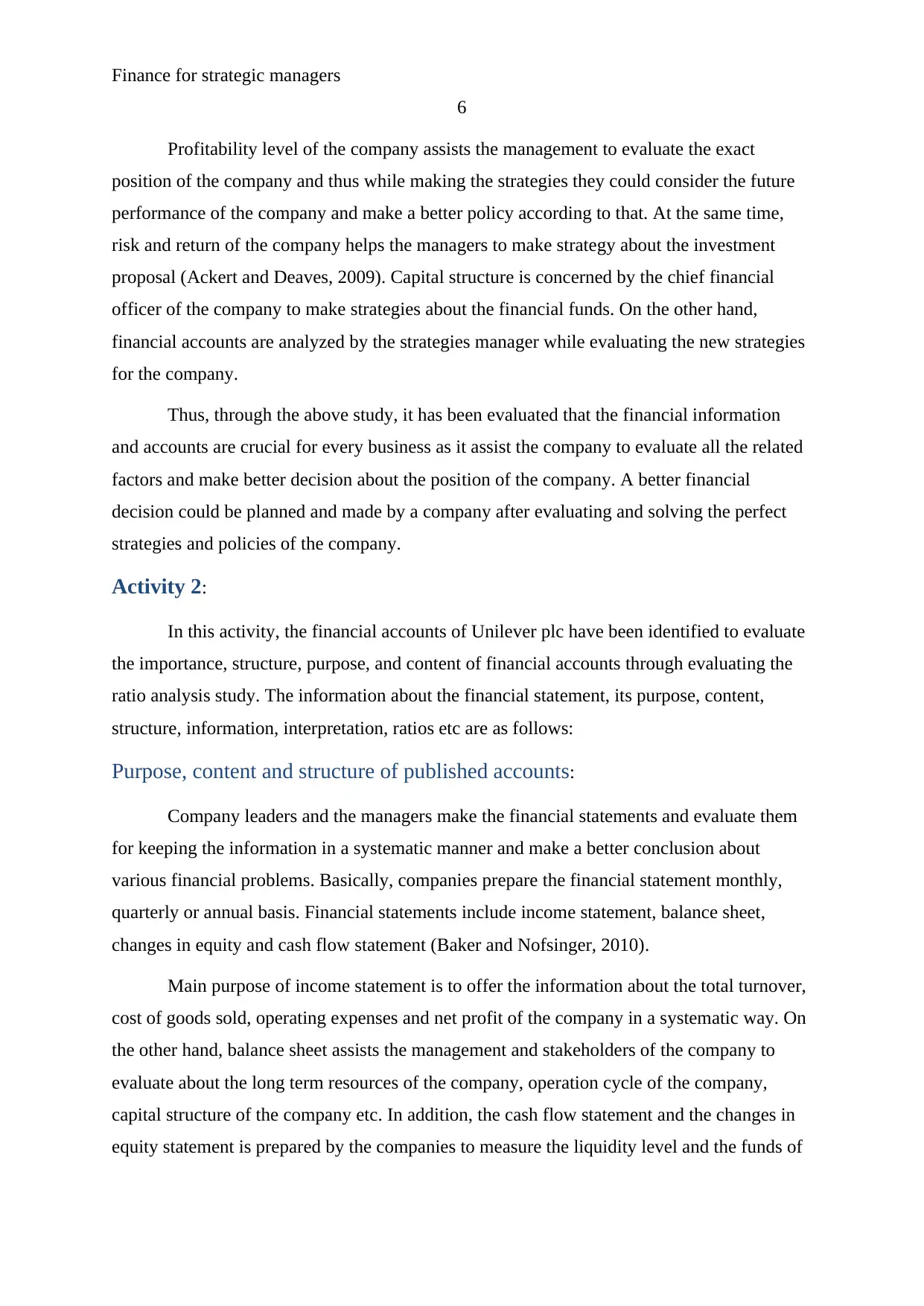
Finance for strategic managers
6
Profitability level of the company assists the management to evaluate the exact
position of the company and thus while making the strategies they could consider the future
performance of the company and make a better policy according to that. At the same time,
risk and return of the company helps the managers to make strategy about the investment
proposal (Ackert and Deaves, 2009). Capital structure is concerned by the chief financial
officer of the company to make strategies about the financial funds. On the other hand,
financial accounts are analyzed by the strategies manager while evaluating the new strategies
for the company.
Thus, through the above study, it has been evaluated that the financial information
and accounts are crucial for every business as it assist the company to evaluate all the related
factors and make better decision about the position of the company. A better financial
decision could be planned and made by a company after evaluating and solving the perfect
strategies and policies of the company.
Activity 2:
In this activity, the financial accounts of Unilever plc have been identified to evaluate
the importance, structure, purpose, and content of financial accounts through evaluating the
ratio analysis study. The information about the financial statement, its purpose, content,
structure, information, interpretation, ratios etc are as follows:
Purpose, content and structure of published accounts:
Company leaders and the managers make the financial statements and evaluate them
for keeping the information in a systematic manner and make a better conclusion about
various financial problems. Basically, companies prepare the financial statement monthly,
quarterly or annual basis. Financial statements include income statement, balance sheet,
changes in equity and cash flow statement (Baker and Nofsinger, 2010).
Main purpose of income statement is to offer the information about the total turnover,
cost of goods sold, operating expenses and net profit of the company in a systematic way. On
the other hand, balance sheet assists the management and stakeholders of the company to
evaluate about the long term resources of the company, operation cycle of the company,
capital structure of the company etc. In addition, the cash flow statement and the changes in
equity statement is prepared by the companies to measure the liquidity level and the funds of
6
Profitability level of the company assists the management to evaluate the exact
position of the company and thus while making the strategies they could consider the future
performance of the company and make a better policy according to that. At the same time,
risk and return of the company helps the managers to make strategy about the investment
proposal (Ackert and Deaves, 2009). Capital structure is concerned by the chief financial
officer of the company to make strategies about the financial funds. On the other hand,
financial accounts are analyzed by the strategies manager while evaluating the new strategies
for the company.
Thus, through the above study, it has been evaluated that the financial information
and accounts are crucial for every business as it assist the company to evaluate all the related
factors and make better decision about the position of the company. A better financial
decision could be planned and made by a company after evaluating and solving the perfect
strategies and policies of the company.
Activity 2:
In this activity, the financial accounts of Unilever plc have been identified to evaluate
the importance, structure, purpose, and content of financial accounts through evaluating the
ratio analysis study. The information about the financial statement, its purpose, content,
structure, information, interpretation, ratios etc are as follows:
Purpose, content and structure of published accounts:
Company leaders and the managers make the financial statements and evaluate them
for keeping the information in a systematic manner and make a better conclusion about
various financial problems. Basically, companies prepare the financial statement monthly,
quarterly or annual basis. Financial statements include income statement, balance sheet,
changes in equity and cash flow statement (Baker and Nofsinger, 2010).
Main purpose of income statement is to offer the information about the total turnover,
cost of goods sold, operating expenses and net profit of the company in a systematic way. On
the other hand, balance sheet assists the management and stakeholders of the company to
evaluate about the long term resources of the company, operation cycle of the company,
capital structure of the company etc. In addition, the cash flow statement and the changes in
equity statement is prepared by the companies to measure the liquidity level and the funds of
⊘ This is a preview!⊘
Do you want full access?
Subscribe today to unlock all pages.

Trusted by 1+ million students worldwide
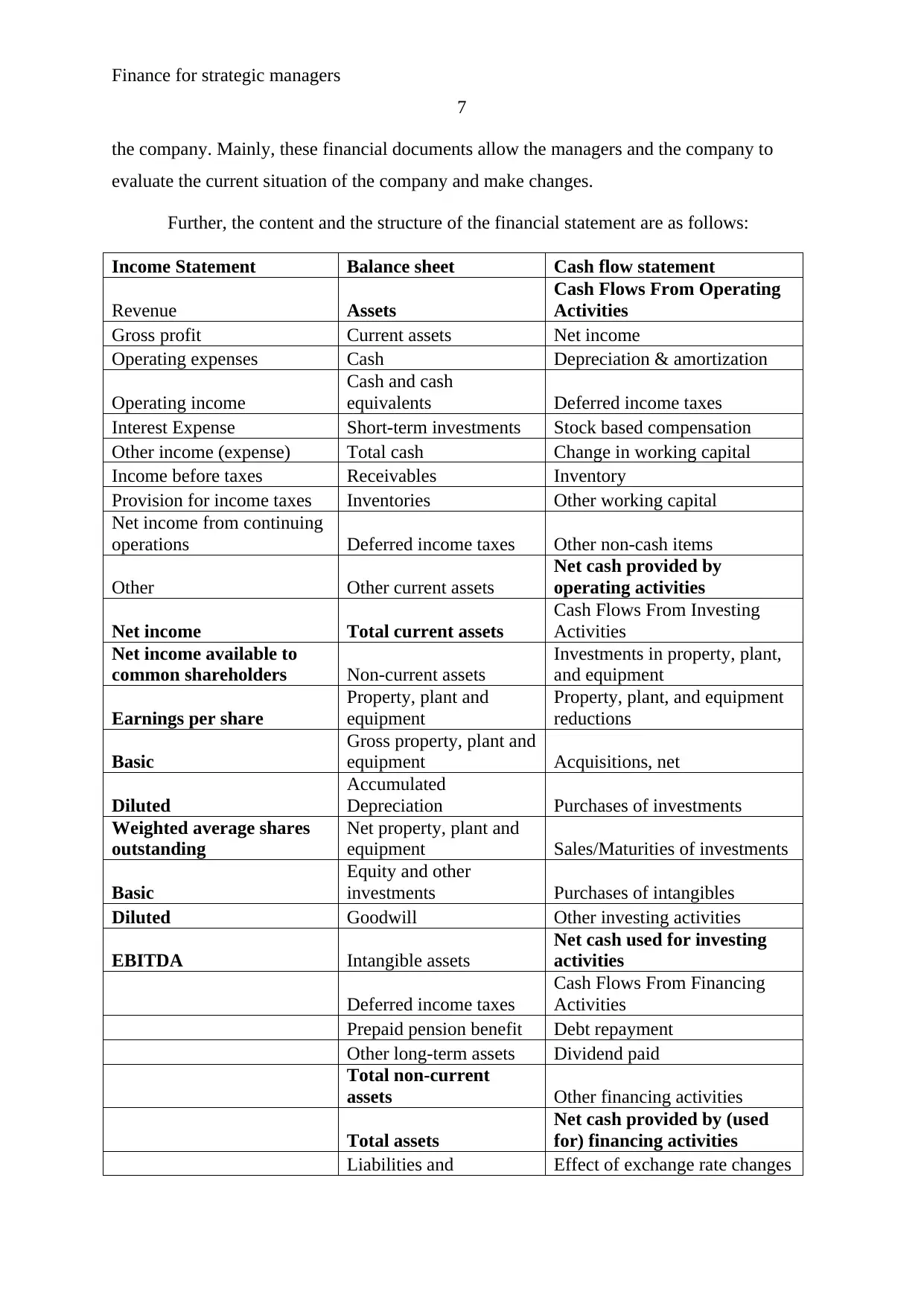
Finance for strategic managers
7
the company. Mainly, these financial documents allow the managers and the company to
evaluate the current situation of the company and make changes.
Further, the content and the structure of the financial statement are as follows:
Income Statement Balance sheet Cash flow statement
Revenue Assets
Cash Flows From Operating
Activities
Gross profit Current assets Net income
Operating expenses Cash Depreciation & amortization
Operating income
Cash and cash
equivalents Deferred income taxes
Interest Expense Short-term investments Stock based compensation
Other income (expense) Total cash Change in working capital
Income before taxes Receivables Inventory
Provision for income taxes Inventories Other working capital
Net income from continuing
operations Deferred income taxes Other non-cash items
Other Other current assets
Net cash provided by
operating activities
Net income Total current assets
Cash Flows From Investing
Activities
Net income available to
common shareholders Non-current assets
Investments in property, plant,
and equipment
Earnings per share
Property, plant and
equipment
Property, plant, and equipment
reductions
Basic
Gross property, plant and
equipment Acquisitions, net
Diluted
Accumulated
Depreciation Purchases of investments
Weighted average shares
outstanding
Net property, plant and
equipment Sales/Maturities of investments
Basic
Equity and other
investments Purchases of intangibles
Diluted Goodwill Other investing activities
EBITDA Intangible assets
Net cash used for investing
activities
Deferred income taxes
Cash Flows From Financing
Activities
Prepaid pension benefit Debt repayment
Other long-term assets Dividend paid
Total non-current
assets Other financing activities
Total assets
Net cash provided by (used
for) financing activities
Liabilities and Effect of exchange rate changes
7
the company. Mainly, these financial documents allow the managers and the company to
evaluate the current situation of the company and make changes.
Further, the content and the structure of the financial statement are as follows:
Income Statement Balance sheet Cash flow statement
Revenue Assets
Cash Flows From Operating
Activities
Gross profit Current assets Net income
Operating expenses Cash Depreciation & amortization
Operating income
Cash and cash
equivalents Deferred income taxes
Interest Expense Short-term investments Stock based compensation
Other income (expense) Total cash Change in working capital
Income before taxes Receivables Inventory
Provision for income taxes Inventories Other working capital
Net income from continuing
operations Deferred income taxes Other non-cash items
Other Other current assets
Net cash provided by
operating activities
Net income Total current assets
Cash Flows From Investing
Activities
Net income available to
common shareholders Non-current assets
Investments in property, plant,
and equipment
Earnings per share
Property, plant and
equipment
Property, plant, and equipment
reductions
Basic
Gross property, plant and
equipment Acquisitions, net
Diluted
Accumulated
Depreciation Purchases of investments
Weighted average shares
outstanding
Net property, plant and
equipment Sales/Maturities of investments
Basic
Equity and other
investments Purchases of intangibles
Diluted Goodwill Other investing activities
EBITDA Intangible assets
Net cash used for investing
activities
Deferred income taxes
Cash Flows From Financing
Activities
Prepaid pension benefit Debt repayment
Other long-term assets Dividend paid
Total non-current
assets Other financing activities
Total assets
Net cash provided by (used
for) financing activities
Liabilities and Effect of exchange rate changes
Paraphrase This Document
Need a fresh take? Get an instant paraphrase of this document with our AI Paraphraser
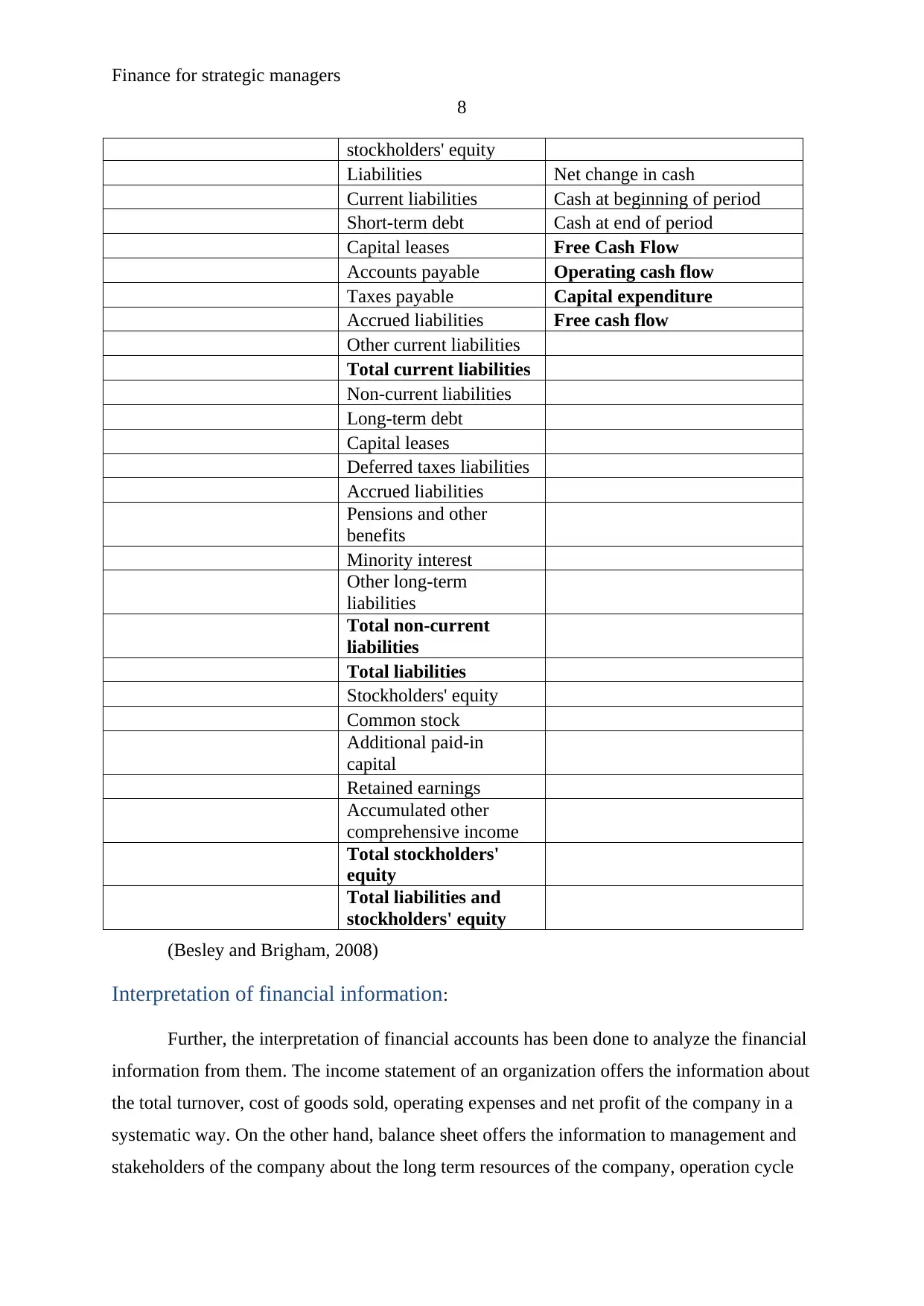
Finance for strategic managers
8
stockholders' equity
Liabilities Net change in cash
Current liabilities Cash at beginning of period
Short-term debt Cash at end of period
Capital leases Free Cash Flow
Accounts payable Operating cash flow
Taxes payable Capital expenditure
Accrued liabilities Free cash flow
Other current liabilities
Total current liabilities
Non-current liabilities
Long-term debt
Capital leases
Deferred taxes liabilities
Accrued liabilities
Pensions and other
benefits
Minority interest
Other long-term
liabilities
Total non-current
liabilities
Total liabilities
Stockholders' equity
Common stock
Additional paid-in
capital
Retained earnings
Accumulated other
comprehensive income
Total stockholders'
equity
Total liabilities and
stockholders' equity
(Besley and Brigham, 2008)
Interpretation of financial information:
Further, the interpretation of financial accounts has been done to analyze the financial
information from them. The income statement of an organization offers the information about
the total turnover, cost of goods sold, operating expenses and net profit of the company in a
systematic way. On the other hand, balance sheet offers the information to management and
stakeholders of the company about the long term resources of the company, operation cycle
8
stockholders' equity
Liabilities Net change in cash
Current liabilities Cash at beginning of period
Short-term debt Cash at end of period
Capital leases Free Cash Flow
Accounts payable Operating cash flow
Taxes payable Capital expenditure
Accrued liabilities Free cash flow
Other current liabilities
Total current liabilities
Non-current liabilities
Long-term debt
Capital leases
Deferred taxes liabilities
Accrued liabilities
Pensions and other
benefits
Minority interest
Other long-term
liabilities
Total non-current
liabilities
Total liabilities
Stockholders' equity
Common stock
Additional paid-in
capital
Retained earnings
Accumulated other
comprehensive income
Total stockholders'
equity
Total liabilities and
stockholders' equity
(Besley and Brigham, 2008)
Interpretation of financial information:
Further, the interpretation of financial accounts has been done to analyze the financial
information from them. The income statement of an organization offers the information about
the total turnover, cost of goods sold, operating expenses and net profit of the company in a
systematic way. On the other hand, balance sheet offers the information to management and
stakeholders of the company about the long term resources of the company, operation cycle
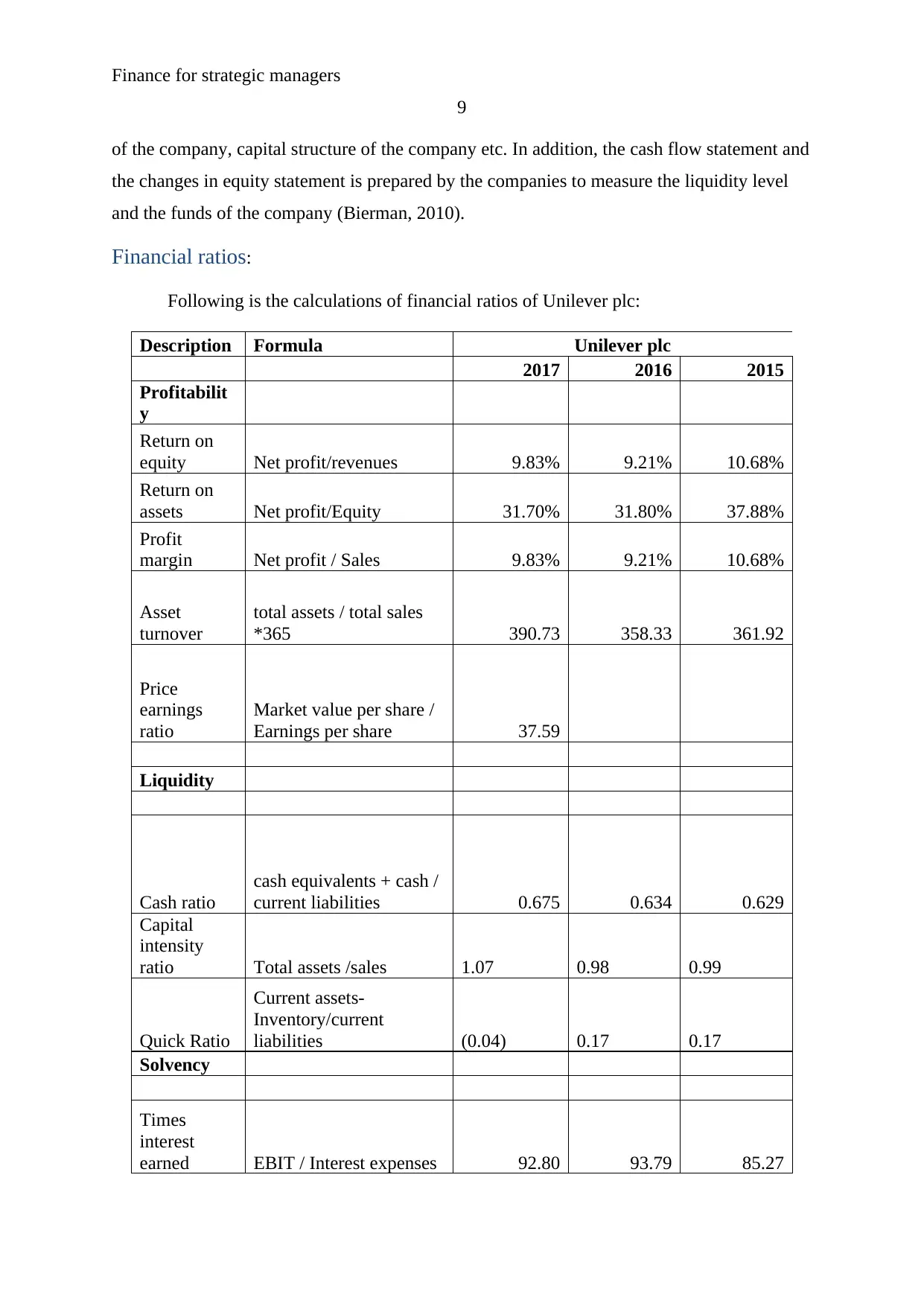
Finance for strategic managers
9
of the company, capital structure of the company etc. In addition, the cash flow statement and
the changes in equity statement is prepared by the companies to measure the liquidity level
and the funds of the company (Bierman, 2010).
Financial ratios:
Following is the calculations of financial ratios of Unilever plc:
Description Formula Unilever plc
2017 2016 2015
Profitabilit
y
Return on
equity Net profit/revenues 9.83% 9.21% 10.68%
Return on
assets Net profit/Equity 31.70% 31.80% 37.88%
Profit
margin Net profit / Sales 9.83% 9.21% 10.68%
Asset
turnover
total assets / total sales
*365 390.73 358.33 361.92
Price
earnings
ratio
Market value per share /
Earnings per share 37.59
Liquidity
Cash ratio
cash equivalents + cash /
current liabilities 0.675 0.634 0.629
Capital
intensity
ratio Total assets /sales 1.07 0.98 0.99
Quick Ratio
Current assets-
Inventory/current
liabilities (0.04) 0.17 0.17
Solvency
Times
interest
earned EBIT / Interest expenses 92.80 93.79 85.27
9
of the company, capital structure of the company etc. In addition, the cash flow statement and
the changes in equity statement is prepared by the companies to measure the liquidity level
and the funds of the company (Bierman, 2010).
Financial ratios:
Following is the calculations of financial ratios of Unilever plc:
Description Formula Unilever plc
2017 2016 2015
Profitabilit
y
Return on
equity Net profit/revenues 9.83% 9.21% 10.68%
Return on
assets Net profit/Equity 31.70% 31.80% 37.88%
Profit
margin Net profit / Sales 9.83% 9.21% 10.68%
Asset
turnover
total assets / total sales
*365 390.73 358.33 361.92
Price
earnings
ratio
Market value per share /
Earnings per share 37.59
Liquidity
Cash ratio
cash equivalents + cash /
current liabilities 0.675 0.634 0.629
Capital
intensity
ratio Total assets /sales 1.07 0.98 0.99
Quick Ratio
Current assets-
Inventory/current
liabilities (0.04) 0.17 0.17
Solvency
Times
interest
earned EBIT / Interest expenses 92.80 93.79 85.27
⊘ This is a preview!⊘
Do you want full access?
Subscribe today to unlock all pages.

Trusted by 1+ million students worldwide
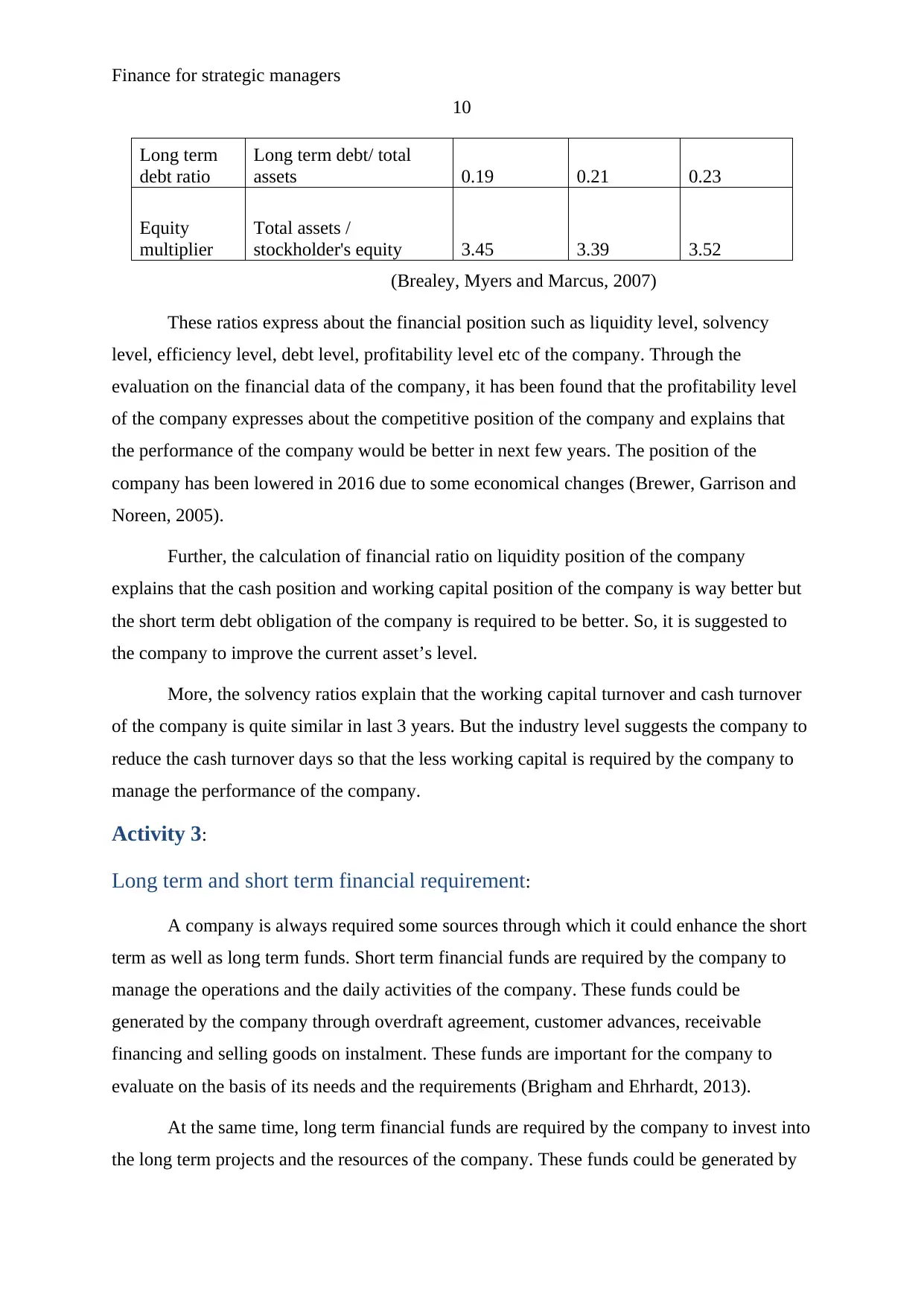
Finance for strategic managers
10
Long term
debt ratio
Long term debt/ total
assets 0.19 0.21 0.23
Equity
multiplier
Total assets /
stockholder's equity 3.45 3.39 3.52
(Brealey, Myers and Marcus, 2007)
These ratios express about the financial position such as liquidity level, solvency
level, efficiency level, debt level, profitability level etc of the company. Through the
evaluation on the financial data of the company, it has been found that the profitability level
of the company expresses about the competitive position of the company and explains that
the performance of the company would be better in next few years. The position of the
company has been lowered in 2016 due to some economical changes (Brewer, Garrison and
Noreen, 2005).
Further, the calculation of financial ratio on liquidity position of the company
explains that the cash position and working capital position of the company is way better but
the short term debt obligation of the company is required to be better. So, it is suggested to
the company to improve the current asset’s level.
More, the solvency ratios explain that the working capital turnover and cash turnover
of the company is quite similar in last 3 years. But the industry level suggests the company to
reduce the cash turnover days so that the less working capital is required by the company to
manage the performance of the company.
Activity 3:
Long term and short term financial requirement:
A company is always required some sources through which it could enhance the short
term as well as long term funds. Short term financial funds are required by the company to
manage the operations and the daily activities of the company. These funds could be
generated by the company through overdraft agreement, customer advances, receivable
financing and selling goods on instalment. These funds are important for the company to
evaluate on the basis of its needs and the requirements (Brigham and Ehrhardt, 2013).
At the same time, long term financial funds are required by the company to invest into
the long term projects and the resources of the company. These funds could be generated by
10
Long term
debt ratio
Long term debt/ total
assets 0.19 0.21 0.23
Equity
multiplier
Total assets /
stockholder's equity 3.45 3.39 3.52
(Brealey, Myers and Marcus, 2007)
These ratios express about the financial position such as liquidity level, solvency
level, efficiency level, debt level, profitability level etc of the company. Through the
evaluation on the financial data of the company, it has been found that the profitability level
of the company expresses about the competitive position of the company and explains that
the performance of the company would be better in next few years. The position of the
company has been lowered in 2016 due to some economical changes (Brewer, Garrison and
Noreen, 2005).
Further, the calculation of financial ratio on liquidity position of the company
explains that the cash position and working capital position of the company is way better but
the short term debt obligation of the company is required to be better. So, it is suggested to
the company to improve the current asset’s level.
More, the solvency ratios explain that the working capital turnover and cash turnover
of the company is quite similar in last 3 years. But the industry level suggests the company to
reduce the cash turnover days so that the less working capital is required by the company to
manage the performance of the company.
Activity 3:
Long term and short term financial requirement:
A company is always required some sources through which it could enhance the short
term as well as long term funds. Short term financial funds are required by the company to
manage the operations and the daily activities of the company. These funds could be
generated by the company through overdraft agreement, customer advances, receivable
financing and selling goods on instalment. These funds are important for the company to
evaluate on the basis of its needs and the requirements (Brigham and Ehrhardt, 2013).
At the same time, long term financial funds are required by the company to invest into
the long term projects and the resources of the company. These funds could be generated by
Paraphrase This Document
Need a fresh take? Get an instant paraphrase of this document with our AI Paraphraser
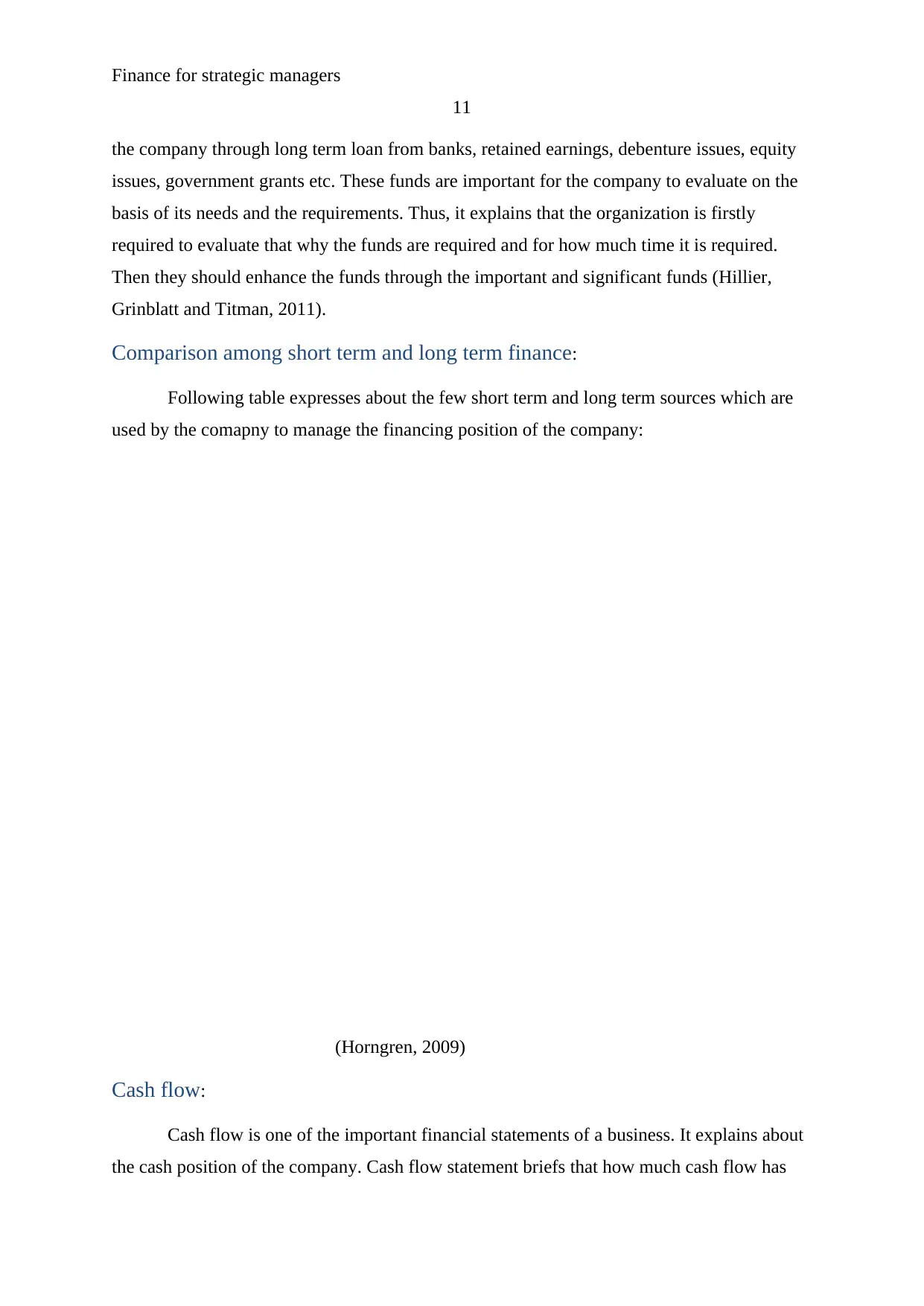
Finance for strategic managers
11
the company through long term loan from banks, retained earnings, debenture issues, equity
issues, government grants etc. These funds are important for the company to evaluate on the
basis of its needs and the requirements. Thus, it explains that the organization is firstly
required to evaluate that why the funds are required and for how much time it is required.
Then they should enhance the funds through the important and significant funds (Hillier,
Grinblatt and Titman, 2011).
Comparison among short term and long term finance:
Following table expresses about the few short term and long term sources which are
used by the comapny to manage the financing position of the company:
(Horngren, 2009)
Cash flow:
Cash flow is one of the important financial statements of a business. It explains about
the cash position of the company. Cash flow statement briefs that how much cash flow has
11
the company through long term loan from banks, retained earnings, debenture issues, equity
issues, government grants etc. These funds are important for the company to evaluate on the
basis of its needs and the requirements. Thus, it explains that the organization is firstly
required to evaluate that why the funds are required and for how much time it is required.
Then they should enhance the funds through the important and significant funds (Hillier,
Grinblatt and Titman, 2011).
Comparison among short term and long term finance:
Following table expresses about the few short term and long term sources which are
used by the comapny to manage the financing position of the company:
(Horngren, 2009)
Cash flow:
Cash flow is one of the important financial statements of a business. It explains about
the cash position of the company. Cash flow statement briefs that how much cash flow has
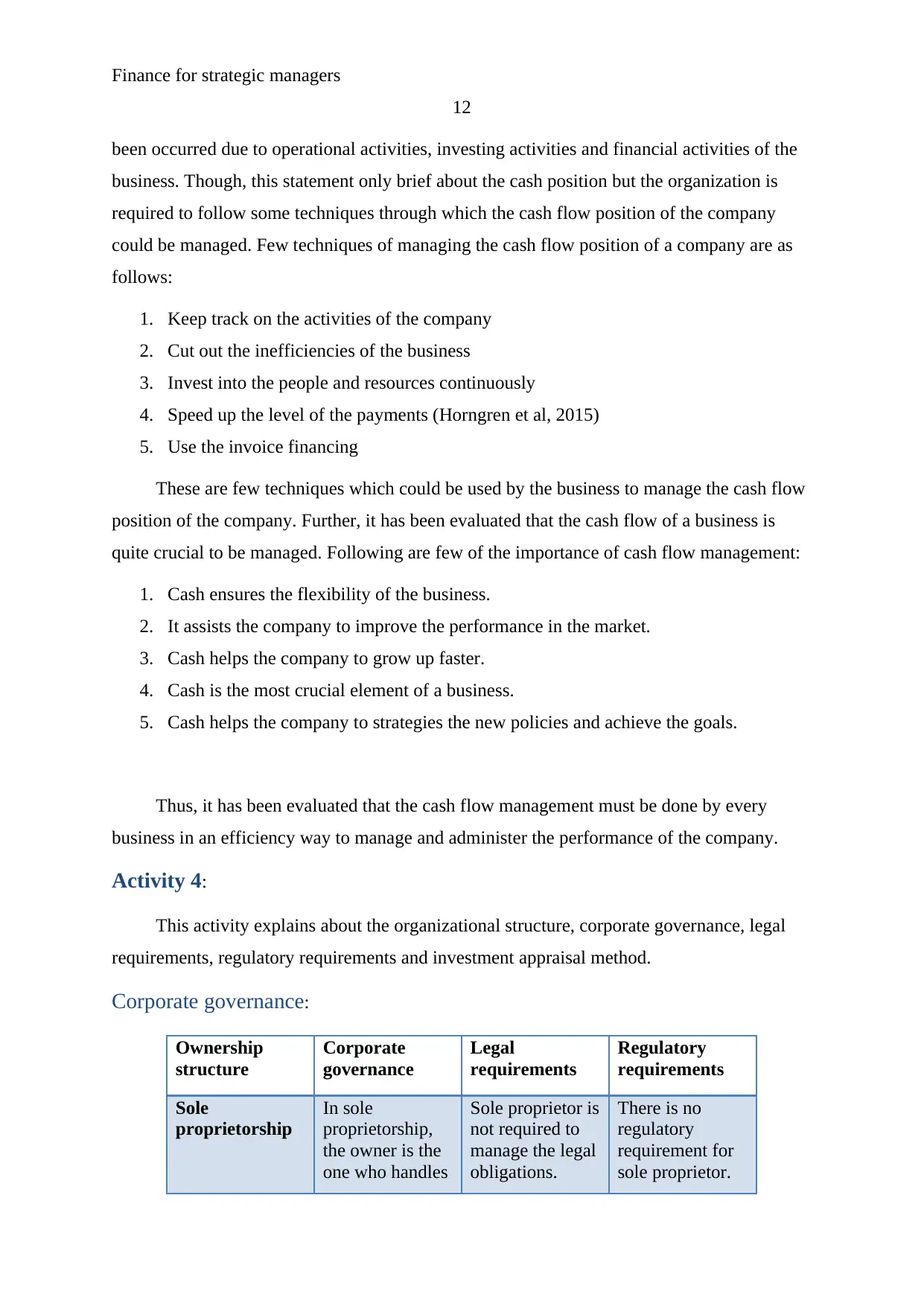
Finance for strategic managers
12
been occurred due to operational activities, investing activities and financial activities of the
business. Though, this statement only brief about the cash position but the organization is
required to follow some techniques through which the cash flow position of the company
could be managed. Few techniques of managing the cash flow position of a company are as
follows:
1. Keep track on the activities of the company
2. Cut out the inefficiencies of the business
3. Invest into the people and resources continuously
4. Speed up the level of the payments (Horngren et al, 2015)
5. Use the invoice financing
These are few techniques which could be used by the business to manage the cash flow
position of the company. Further, it has been evaluated that the cash flow of a business is
quite crucial to be managed. Following are few of the importance of cash flow management:
1. Cash ensures the flexibility of the business.
2. It assists the company to improve the performance in the market.
3. Cash helps the company to grow up faster.
4. Cash is the most crucial element of a business.
5. Cash helps the company to strategies the new policies and achieve the goals.
Thus, it has been evaluated that the cash flow management must be done by every
business in an efficiency way to manage and administer the performance of the company.
Activity 4:
This activity explains about the organizational structure, corporate governance, legal
requirements, regulatory requirements and investment appraisal method.
Corporate governance:
Ownership
structure
Corporate
governance
Legal
requirements
Regulatory
requirements
Sole
proprietorship
In sole
proprietorship,
the owner is the
one who handles
Sole proprietor is
not required to
manage the legal
obligations.
There is no
regulatory
requirement for
sole proprietor.
12
been occurred due to operational activities, investing activities and financial activities of the
business. Though, this statement only brief about the cash position but the organization is
required to follow some techniques through which the cash flow position of the company
could be managed. Few techniques of managing the cash flow position of a company are as
follows:
1. Keep track on the activities of the company
2. Cut out the inefficiencies of the business
3. Invest into the people and resources continuously
4. Speed up the level of the payments (Horngren et al, 2015)
5. Use the invoice financing
These are few techniques which could be used by the business to manage the cash flow
position of the company. Further, it has been evaluated that the cash flow of a business is
quite crucial to be managed. Following are few of the importance of cash flow management:
1. Cash ensures the flexibility of the business.
2. It assists the company to improve the performance in the market.
3. Cash helps the company to grow up faster.
4. Cash is the most crucial element of a business.
5. Cash helps the company to strategies the new policies and achieve the goals.
Thus, it has been evaluated that the cash flow management must be done by every
business in an efficiency way to manage and administer the performance of the company.
Activity 4:
This activity explains about the organizational structure, corporate governance, legal
requirements, regulatory requirements and investment appraisal method.
Corporate governance:
Ownership
structure
Corporate
governance
Legal
requirements
Regulatory
requirements
Sole
proprietorship
In sole
proprietorship,
the owner is the
one who handles
Sole proprietor is
not required to
manage the legal
obligations.
There is no
regulatory
requirement for
sole proprietor.
⊘ This is a preview!⊘
Do you want full access?
Subscribe today to unlock all pages.

Trusted by 1+ million students worldwide
1 out of 22
Related Documents
Your All-in-One AI-Powered Toolkit for Academic Success.
+13062052269
info@desklib.com
Available 24*7 on WhatsApp / Email
![[object Object]](/_next/static/media/star-bottom.7253800d.svg)
Unlock your academic potential
Copyright © 2020–2025 A2Z Services. All Rights Reserved. Developed and managed by ZUCOL.





